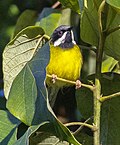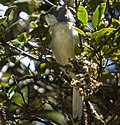| Image | Common name | Scientific name | Distribution |
|---|
 | Bar-throated apalis | Apalis thoracica | Afromontane and proximate elevated areas of southeastern Africa |
 | Yellow-throated apalis | Apalis flavigularis | Malawi. |
| Taita apalis | Apalis fuscigularis | Kenya |
| Namuli apalis | Apalis lynesi | Mozambique |
 | Rudd's apalis | Apalis ruddi | Mozambique, southern Malawi, South Africa and Eswatini |
| Brown-tailed apalis | Apalis flavocincta [10] | Ethiopia, Sudan, and Uganda to Somalia and Kenya |
 | Yellow-breasted apalis | Apalis flavida | Sub-Saharan Africa |
 | Lowland masked apalis | Apalis binotata | Angola, Cameroon, Democratic Republic of the Congo, Equatorial Guinea, Gabon, Tanzania, and Uganda |
 | Mountain masked apalis | Apalis personata | Albertine Rift montane forests |
 | Black-throated apalis | Apalis jacksoni | Cameroon to Kenya |
 | White-winged apalis | Apalis chariessa | Kenya, Malawi, Mozambique, and Tanzania |
 | Black-capped apalis | Apalis nigriceps | African tropical rainforest |
 | Black-headed apalis | Apalis melanocephala | Kenya, Malawi, Mozambique, Somalia, Tanzania, and Zimbabwe |
 | Chirinda apalis | Apalis chirindensis | Zimbabwe and Mozambique |
 | Chestnut-throated apalis | Apalis porphyrolaema | Burundi, Democratic Republic of the Congo, Kenya, Rwanda, Tanzania and Uganda |
| Kabobo apalis | Apalis kaboboensis | Democratic Republic of the Congo |
| Chapin's apalis or chestnut-headed apalis | Apalis chapini | Malawi, Tanzania, and Zambia |
 | Sharpe's apalis | Apalis sharpii | Côte d'Ivoire, Ghana, Guinea, Liberia, and Sierra Leone |
 | Buff-throated apalis | Apalis rufogularis | Angola, Benin, Burundi, Cameroon, Central African Republic, Republic of the Congo, Democratic Republic of the Congo, Equatorial Guinea, Gabon, Kenya, Nigeria, Rwanda, South Sudan, Tanzania, Uganda, and Zambia |
| Kungwe apalis | Apalis argentea | Burundi, Democratic Republic of the Congo, Rwanda, and Tanzania |
| Karamoja apalis | Apalis karamojae [11] | Tanzania, Uganda and Kenya |
 | Maasai apalis | Apalis stronachi | Tanzania and Kenya |
 | Bamenda apalis | Apalis bamendae | Cameroon |
 | Gosling's apalis | Apalis goslingi | Angola, Cameroon, Central African Republic, Republic of the Congo, Democratic Republic of the Congo, and Gabon |
 | Grey apalis | Apalis cinerea | Angola, Burundi, Cameroon, Democratic Republic of the Congo, Equatorial Guinea, Gabon, Kenya, Nigeria, Rwanda, South Sudan, Sudan, Tanzania, and Uganda |
| Brown-headed apalis | Apalis alticola | Angola, Zambia, Malawi, south-eastern Democratic Republic of Congo, Tanzania and Kenya |
|


















